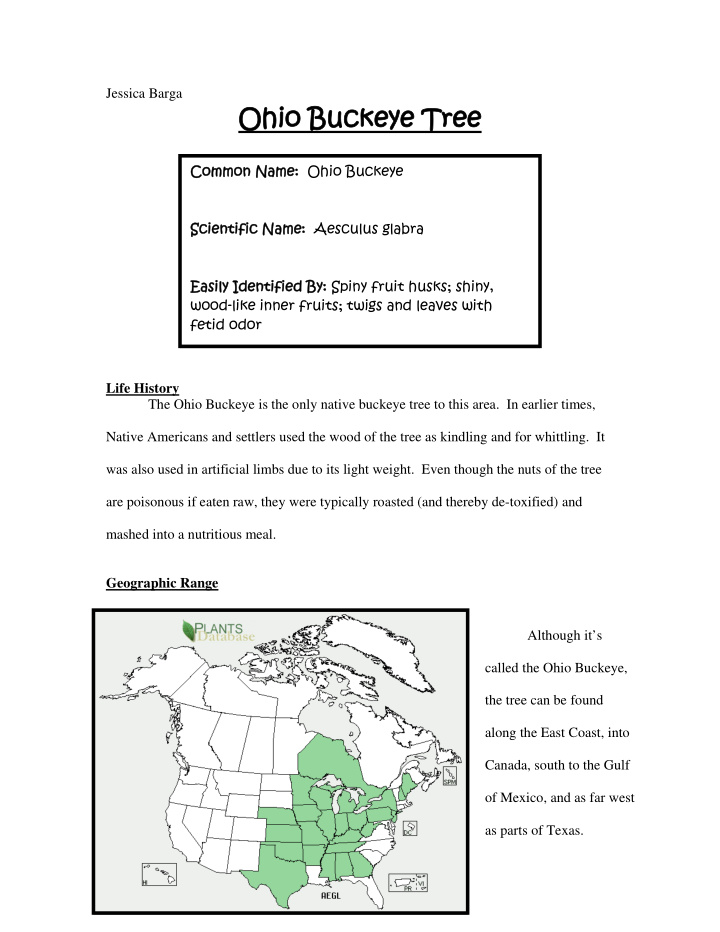



Jessica Barga Ohio B Buck ckeye T eye Tre ree Commo mmon Name Name: Ohio Buckeye Scienti tifi fic Name Name: Aesculus glabra Easi Easily Id Identi tifi fied B d By: Spiny fruit husks; shiny, wood-like inner fruits; twigs and leaves with fetid odor Life History The Ohio Buckeye is the only native buckeye tree to this area. In earlier times, Native Americans and settlers used the wood of the tree as kindling and for whittling. It was also used in artificial limbs due to its light weight. Even though the nuts of the tree are poisonous if eaten raw, they were typically roasted (and thereby de-toxified) and mashed into a nutritious meal. Geographic Range Although it’s called the Ohio Buckeye, the tree can be found along the East Coast, into Canada, south to the Gulf of Mexico, and as far west as parts of Texas.
Size The tree is typically anywhere from 30-50 feet tall, although there are variants. When growing in the understories of woods and forests, they are typically much smaller than those growing in open fields or meadows. The tallest known specimen is 77 feet tall. The Ohio Buckeye is often classified as a ‘small tree’. Leaf & Stem Characteristics Ohio Buckeye leaves grow in compoundly palmate leaflets of five to nine, are arranged oppositely, and are usually irregularly toothed. The leaves are typically 3 to 6 inches long and ovately-shaped. The Ohio Buckeye is one of the first trees to leaf out in the spring and one of the first to lose its leaves in the autumn. The stems have a disagreeable odor when broken and are a brownish or grayish color. The bark is an ashy color that can have an unpleasant smell and may have a wrinkled appearance on older trees. Flower & Fruit Characteristics
Buckeye flowers are usually less than an inch long and are grouped in upright clusters. They are typically pale- yellow or greenish in color and occur during mid-spring. Fruits are produced in late summer and fall and are comprised of a dehiscent, spiny, fleshy husk surrounding a shiny, wood-like nut. Each husk may contain one or more buckeye seeds inside. Fungal & Insect Pests Although hardy, the Buckeye can fall victim to leaf blot and scorch and powdery mildew. Thus, the tree prefers to be planted in a mostly-shaded area. Insects are typically not a problem, although the tree does host the buckeye lace bug and the walnut scale. These insects do not usually cause serious damage to the tree itself. Economic Importance Buckeye trees’ light wood is used chiefly as lumber and in paper pulp. As previously mentioned, at one time, it was used in making artificial limbs because of its light weight and ease of whittling. Ohio Buckeyes are typically available in tree nurseries and are the official state tree of Ohio. Interesting Facts The name of the tree comes from the Native Americans, who compared the dark- brown nut to the eye of a male deer (hence the name Buckeye). Native Americans and
early settlers also used the nut for its supposed medicinal and ‘talismanic’ properties. And U.S. President and Miami alumnus William Henry Harrison adopted the buckeye as a symbol of his presidential campaign. Multiple Choice The Ohio Buckeye belongs to the Hippocastanaceae family, which also includes which of these trees? a) Sugar Maple b) Kentucky Coffeetree c) Horse-Chestnut d) American Beech Resources • The Illustrated Book of Trees, William Carey Grimm, & circular key • http://www.ohio-nature.com/buckeye-tree.html • http://www.dnr.state.oh.us/tabid/5107/default.aspx • http://www.ehow.com/info_10041391_insects-attack-buckeye-trees.html • http://plants.usda.gov/java/profile?symbol=aegl • http://www.statesymbolsusa.org/Ohio/state-tree-ohio.html • http://www.cas.vanderbilt.edu/bioimages/species/aegl.htm
Recommend
More recommend